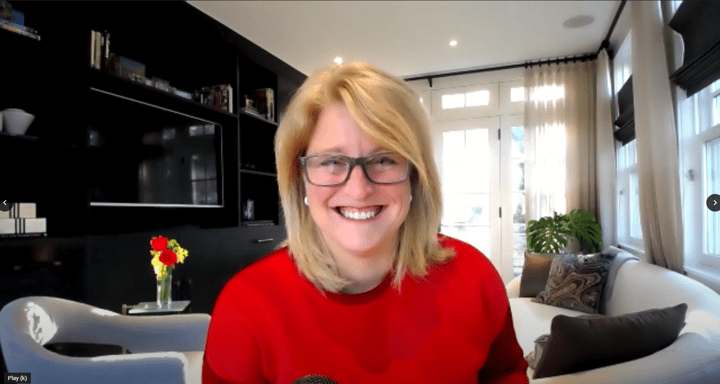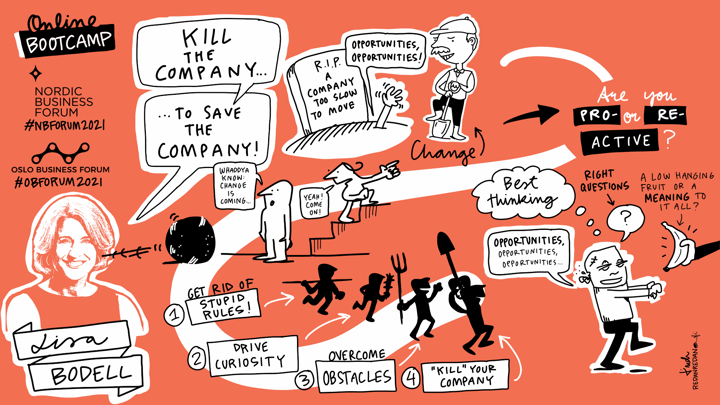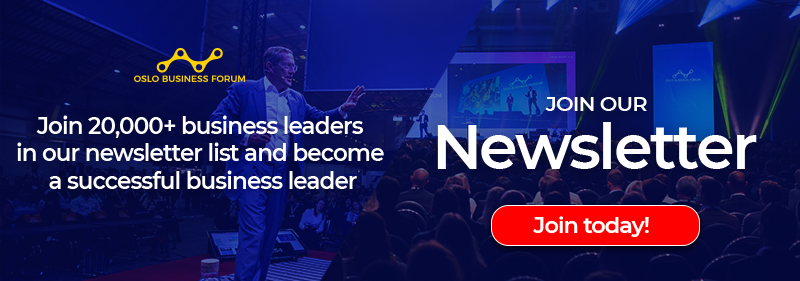“The best ideas typically happen when we’re alone. The best ideas are typically built when we’re together.”
Lisa Bodell is an award-winning author and CEO of FutureThink. As a futurist and expert on innovation and simplicity, she has helped thousands of leaders ignite change in their organizations. Lisa serves as a global council member of the World Economic Forum and was recently selected as one of the Top 50 Keynote Speakers in the World. She is the author of two bestselling books and has appeared in Fast Company, The New York Times, and WIRED, among other publications.
At the Online Bootcamp, Lisa challenged the participants to embrace change and offered four techniques to identify weaknesses, overcome obstacles, and ignite transformation.

Successful Teams Embrace Change
Recent history has demonstrated that the ability to pivot quickly during times of change is absolutely critical in business. Over the past year, many of us have been forced to embrace agility, asking ourselves, “what else,” “who else,” and “how else?” We’ve had to rethink the way we do business, transforming our products, processes, and partnerships. And, unfortunately, we’ve done so reactively, scrambling to enact change in times of extreme uncertainty.
Under more ideal circumstances, leaders and their organizations would be prepared to behave proactively. We would anticipate opportunities and be positioned to take advantage of them. We would see possibilities and not problems. We would let go of the past and embrace the future.
“When you look at people who are really innovative, they are not just agile but they have this mindset that it’s not just about looking at problems but seeing possibilities.”
As a futurist and expert on innovation, Lisa Bodell believes that the most successful teams embrace change. They recognize that the future is not what their organization is today, but what it must become tomorrow. But becoming what we must be in the future requires transformation—and transformation requires us to let go of the habits that are holding us back.
What’s Holding You Back?
There’s never been a better time to change your mindset, challenge your assumptions, and transform the way you do things at work. But chances are, there are a number of things holding you and your team back.
Lisa shared three common habits that prevent organizations from embracing change and successfully transforming.
- We value more work over meaningful work. How much is on our to-do lists is not as important as what is on our to-do lists. We have to take a hard look at where we’re spending our time today and make more room to engage in valuable, meaningful work. Lisa encouraged leaders to remember that time is a non-renewable resource, and to be more intentional about how we use it, we must say “yes” with intention and “no” with purpose.
- We focus internally rather than externally. “The future is outside the organization, not necessarily in it.” We have to shift the balance, looking outwardly more often. Lisa noted that when we examine our to-do lists, we’ll notice that the tasks we consider obligatory—the things we have to do—are often internal. Our desired work—the things we want to do—are most often external.
- We spend more time doing than thinking. To innovate and execute, we need time to think, consider, and imagine. Too often, we use meetings as brainstorming sessions, gathering our teams forcing them to come up with ideas. But, Lisa reminded leaders, truthfully, our best ideas usually occur when we’re alone. Give yourself and your team the space to think, then bring everyone together to build.
Breaking these habits will help you make change a part of the day-to-day for you and your team. It will help you challenge the way you work today and welcome a new way of doing things tomorrow. It will help you ignite transformation.
Four Techniques to Ignite Transformation
Lisa’s work with leading organizations has led her to uncover four techniques that will help you identify weaknesses, overcome challenges, and ignite transformation. She believes that embracing any one of these techniques will allow you to visualize what your organization must become in the future and begin to move in that direction.
#1: Kill Stupid Rules
Getting rid of stupid rules will help you question the way you do things at work and identify low-hanging fruit within the scope of your control.
Lisa argued that if we fail to question how we do things at work, we fall into what we think is a groove but is actually a rut. We go through the same motions—and repeat the same mistakes—over and over again. To challenge the way things are done today, ask your team, “If we could get rid of two rules to help us be more productive, what would they be?” You might be surprised to discover that many of the “rules” your team identifies aren’t rules at all but cultural norms that are well within your sphere of influence.
.jpg?width=720&name=MaxEmanuelson__MAX6943%20(1).jpg)
#2: Drive Curiosity
Leaders can—and should—drive curiosity by asking better questions. More provocative questions offer another method of challenging your way of thinking and revealing better ways to get things done. “In the future, asking the right questions will become more valuable than finding answers. Humans are for questions, machines are for answers.”
Asking better questions will bring your team out of their comfort zone and inspire their resourcefulness, creativity, and innovation. Lisa suggested that the next time you enter a meeting, you ask your team, “What are your biggest time-wasters, and how can we fix them?” You’re likely to uncover tasks that make up impressively long to-do lists but that can’t be categorized as valuable or meaningful work.
#3: Overcome Obstacles
We’re better at solving other peoples’ problems than our own. For help overcoming obstacles, give your problems away and seek solutions from others.
As a leader, you likely spend a significant amount of time considering your problems, turning over solutions, and promptly rejecting them. But when you’re presented with an opportunity to solve someone else’s problem, you’re quick to identify and offer an answer. Lisa challenged you to enlist the support of someone else for help overcoming the biggest obstacles that are in your way.
#4: Kill Your Company
To uncover your biggest weaknesses and determine what needs to change, put yourself in your competitors’ shoes and pretend to “kill your company.”
Lisa acknowledged that while “killing the company” may sound extreme, it’s an exercise that effectively opens minds. The next time you gather your team, ask them to identify your number one competitor and put on that competitor’s mindset. Act as if that competitor is putting you out of business. It will lead you to identify what’s wrong and what needs to change.
Lisa asked all leaders to commit to testing at least one of these techniques. Doing so will help you and your team determine who you need to become and how to do more work that matters. “Simplicity is free. Give yourself a shot at actually embracing change and getting to more work that matters.”

Key Points
- The most successful teams recognize that the future is not what your organization is today, but what it must become.
- Embracing change and agility will help you identify weaknesses, overcome challenges, and ignite transformation.
- Killing stupid rules will help you question the way you do things at work and identify low-hanging fruit within the scope of your control.
- Leaders can drive curiosity by asking better questions to challenge ways of thinking and reveal better ways to get things done.
- We’re better at solving other peoples’ problems than our own. For help overcoming obstacles, give your problems away and seek solutions from others.
- To uncover your biggest weaknesses and determine what needs to change, put yourself in your competitors’ shoes and pretend to “kill your company.”
- Real change occurs when you engage people to shift their behavior together.
Questions to Consider
- How does your company need to transform? Does your culture support the change and agility necessary to do so?
- Which rules or norms can you kill to help you and your team become more productive?
- How can you ask your team better questions to challenge their thinking and reveal better ways to get things done?
- How could “giving away your problems” help you overcome obstacles? Are you open to the solutions you might receive in return?
- If you were to put yourself in the mindset of your biggest competitor, what weaknesses would you see? How would it inspire you to change?
